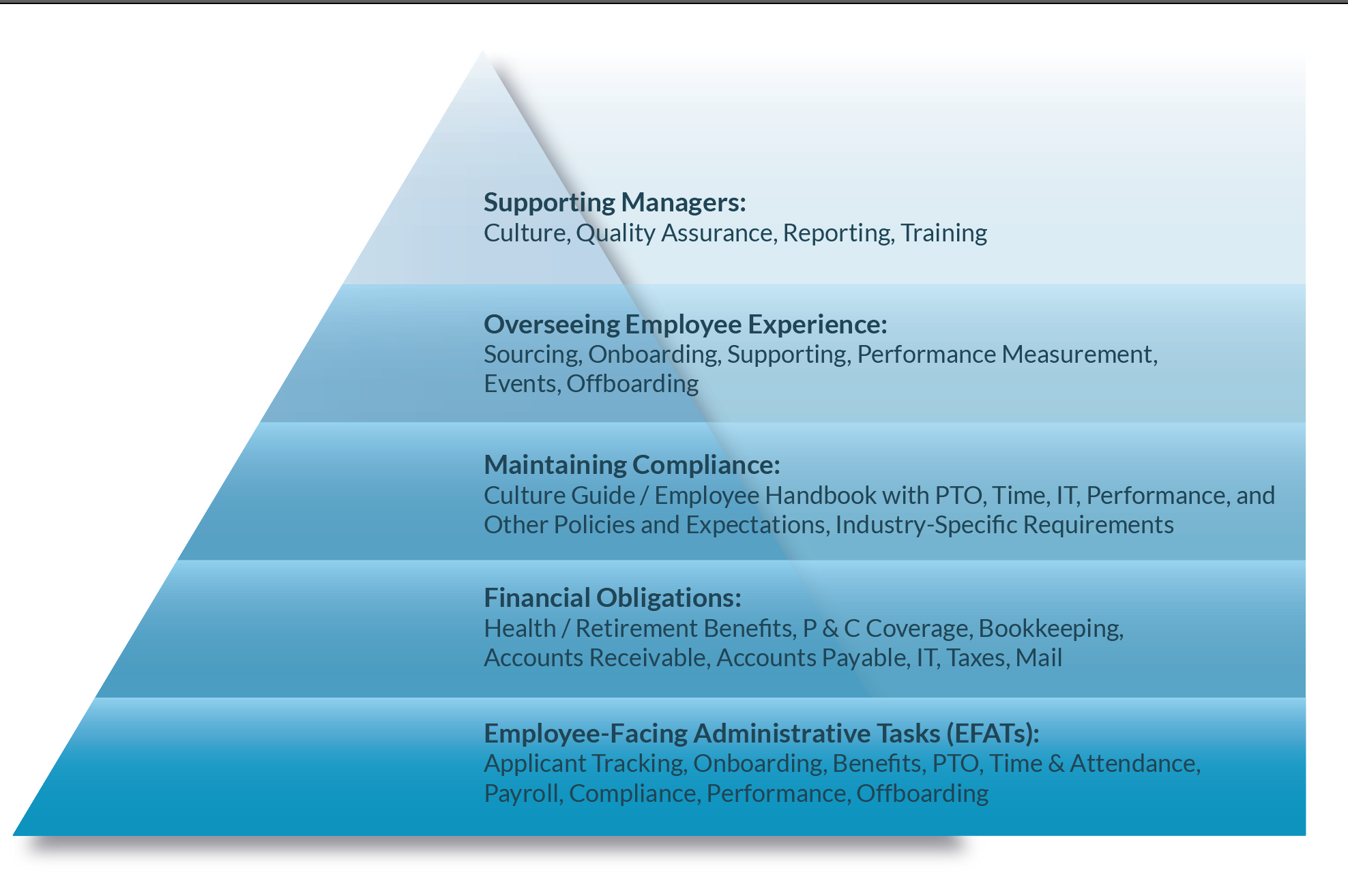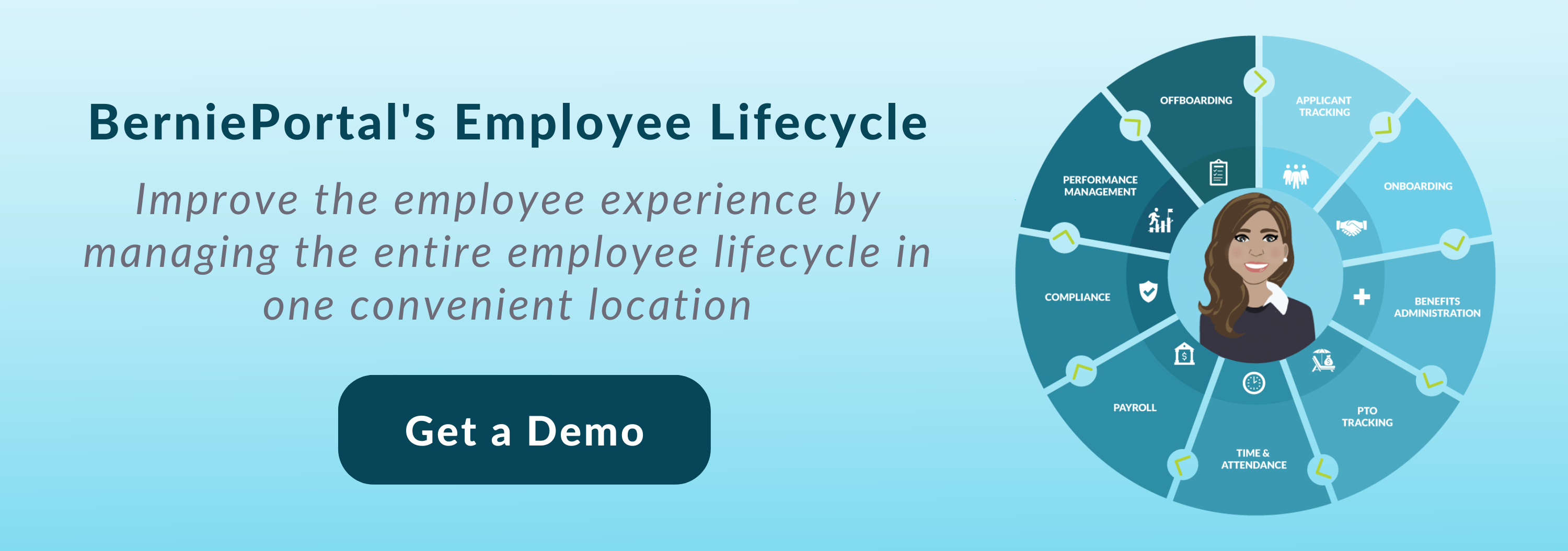
Written by
Alex Tolbert
Alex is the founder and CEO of BerniePortal. He is a recognized thought leader on technology, HR and benefits.
What Is the HR Hierarchy of Needs?

For more than 15 years, BerniePortal has worked with thousands of HR professionals across the country just like you. During that time in the trenches, we’ve observed first-hand the challenges HR at a small employer faces. It’s what inspired our popular YouTube series: HR Party of One!
Our observations over all of that time also inspired the framework that I’m thrilled to share with you today: HR’s Hierarchy of Needs. It outlines the five basic levels of needs HR parties of one have and can address for their organizations. By applying it to what you do every day, you’ll be able to drive value for your organization more effectively and, in turn, grow your career. We know of no other framework or rigorous thinking applied to what you do every day than this, and so I’m PUMPED to share it with you.
As you probably have noticed, the pyramid was inspired by Maslow's hierarchy in conjunction with our experience working in HR. Our pyramid works similar to Maslow's in that you have to address the lower level needs before you can work on the higher level ones. The HR Hierarchy of Needs has five levels:
- Level One: Employee-Facing Administrative Tasks (EFATs)
- Level Two: Financial Obligations
- Level Three: Maintaining Compliance
- Level Four: Overseeing Employee Experience, and finally,
- Level Five: Supporting Managers
Let’s go through each of these in more detail, starting with Level One.
Level One: Employee-Facing Administrative Tasks (EFATs)
The bottom of the pyramid, your base level HR necessities that monopolize your time, are your Employee-Facing Administrative Tasks, or EFATs. These tasks consist of applicant tracking, onboarding, benefits, PTO, time & attendance, payroll, compliance, performance, and offboarding.
As an HR party of one, if you don’t have an effective system in place for EFATs, your employees will constantly harass you with questions and complaints.
“How much PTO do I have left?”
“I need a paystub from last quarter. Can you send it to me?”
“What are my dental plan options? Can I get my spouse enrolled?”
These questions eat up your time, keeping you from moving up the pyramid. You want to support managers and improve employee experience at your organization, but you simply don’t have the time.
Without an HRIS, you better shake hands with EFATs—y’all are gonna be best buds for the long haul.
Next, you have your secondary best bud in finance at level two of the pyramid.
Level Two: Financial Obligations
The second level of the hierarchy consists of the financial obligations that keep a business running. As an HR party of one, it would be your responsibility to take on financial-related obligations at a high level. This means administering the benefits package. Securing the right insurance coverages. Overseeing, or doing bookkeeping. Accounts receivable. Accounts payable. IT. Taxes. Mail. You see how long the list goes on?
Now—add your financial obligations to your EFATs and you could be pulling 60-hour workweeks, and STILL not be even close to ever getting to the top of the pyramid. And it doesn’t end here. The absolute necessities of your role that cannot fall by the wayside continue into the next level of the HR hierarchy of needs.
Level Three: Maintaining Compliance
Compliance isn’t optional. Without meeting compliance regulations, there can be serious penalties, ultimately resulting in shutting down the business if they’re persistently not followed. Some of the most prominent regulations include:
- Fair Labor Standards Act (FLSA)
- Affordable Care Act (ACA)
- Family and Medical Leave Act (FMLA)
- Title VII of the Civil Rights Act
- Occupational Safety and Health Act (OSHA)
- Equal Pay Act (EPA)
- Americans with Disabilities Act
Compliance also includes creating and maintaining a Culture Guide or Employee Handbook for your organization to establish written documentation and culture expectations, as well as other basic policies that your workforce must follow. It includes filling out Forms 1094-C and 1095-C. It includes COBRA coverage. HIPAA. Equal Employment Opportunity (EEOC).
And the list continues.
Maintaining compliance can be made into a full-time job in itself. As can EFATs. As can financial obligations. It is so critical, though, that HR parties of one not let this happen. If you do, it will prevent you from ever being able to really drive the organization forward, which really starts at Level Four: Overseeing Employee Experience.
Level Four: Overseeing Employee Experience
If you haven’t gotten to this point yet, this is where you get to thrive. There are probably many things lacking at your organization that you’ve noticed, but just never have the time to address. Perhaps you don’t have a set onboarding process. Maybe your company has a high turnover rate and low employee satisfaction. You know that not solving these issues will risk the success of the business long-term, but not nearly as much as ignoring EFATs, financial obligations and compliance regulations would in the near-term.
While the lower three levels of the pyramid are essential to keep a business, well—in business, at this fourth level, you can actually help improve the business and drive it forward.
You can source new talent, recruiting valuable ADDS to your company. You can properly onboard them so that they are fully equipped to dive into their roles with a sense of belonging and value. You’ll have the time to support your employees, to check-in on them to see how they are doing. Are they happy? Is there anything you can do to help them?
Having time to focus on employee experience leads to happier, more fulfilled employees, which in turn, makes them want to stay. Retention rates increase, sourcing talent costs decrease, the business starts to grow and increase profit…do you see a beautiful long-term pattern in the works?
Let’s keep it going!
Finally, we have the top level of the pyramid:
Level Five: Supporting Managers
Having top-tier managers is critical to gaining and keeping top-tier employees. According to a study by Gallup, the number one reason an employee leaves their job is to get away from their manager. But yet, most companies don’t have best practices in place for management, or they don’t have any systems or people ensuring that best practices are followed.
To support managers effectively, you can start by simply following up on what leadership is already saying they want managers to do, but the managers aren’t necessarily doing. For instance, if leadership has said that managers should spend 20% of their work weeks recruiting for open positions, but you notice some managers aren’t recruiting at all, here’s your chance to step in and follow-up. Send an email to all managers, copying leadership, reminding the managers about leadership wanting managers spending 20% of their time recruiting. Suggest managers spend the first 90 minutes of their day reaching out to potential candidates on LinkedIn, or calling on their personal networks to look for candidates.
Once you start supporting managers with these HR-related follow-ups on what leadership has said it wants, you’ll be helping to improve the business and your influence will grow over time. They may start to seek you out and ask you questions, and your position to support managers will grow.
But you’ll need to have the time to do that, and you’ll only have that time if you manage how much time you’re spending on the lower levels of the hierarchy effectively!
Here at BerniePortal, we want to help you do that. Our software, BerniePortal, helps you minimize how much time you spend on the Employee-Facing Administrative Tasks, or EFATs. Our content and resources - from HR Party of One to BernieU courses to our blog and downloadable templates to the HR Party of One Community - help you address the other tiers most effectively.
We’ll be circling back to the HR Hierarchy of Needs framework often, as so much of what we do in HR relates to how we’re managing our work across it!
Additional Resources
You can stay informed, educated, and up to date with important HR topics using BerniePortal’s comprehensive resources:
- BernieU—free online HR courses, approved for SHRM and HRCI recertification credit
- BerniePortal Blog—a one-stop shop for HR industry news
- HR Glossary—featuring the most common HR terms, acronyms, and compliance
- Resource Library—essential guides covering a comprehensive list of HR topics
- HR Party of One—our popular YouTube series and podcast, covering emerging HR trends and enduring HR topics

Written by
Alex Tolbert
Alex is the founder and CEO of BerniePortal. He is a recognized thought leader on technology, HR and benefits.





Submit a Comment